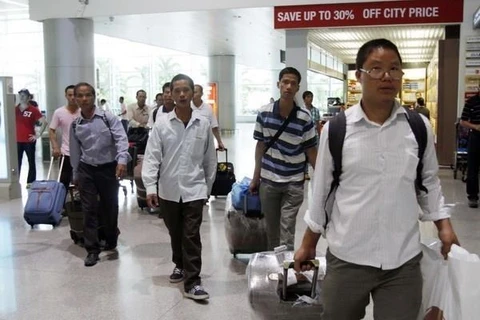Hanoi (VNA) – Japan has continued to be the largest market for Vietnamese labourers so far, and it is expected to offer many more job opportunities with high income in the remaining months of the year.
In the first nine months of 2019, Vietnam sent 104,615 labourers abroad, including 35,815 women, equivalent to 87.2 percent of the year’s target of 120,000, according to the latest report of the Department of Overseas Labour under the Ministry of Labour, Invalids and Social Affairs (MoLISA).
During the reviewed period, Japan was the biggest recipient with 53,610 Vietnamese labourers, including 20,250 women. It was followed by Taiwan (China) 41,174, the Republic of Korea 5,898, Romania 1,103, Saudi Arabia 817, Macau (China) 324, and Malaysia 304.
In September alone, 12,950 people went to work abroad, equivalent to 80 percent of the figure in the same period last year.
Nguyen Gia Liem, Deputy Director of the Department of Overseas Labour, said Taiwan (China) and Japan are the traditional and also biggest markets of Vietnamese labourers as they have been the destinations of more than 90 percent of Vietnam’s total guest workers in the recent past.
Japan is the most potential market at present, he noted, adding that it not only offers good salary but also provides numerous job opportunities for skilled workers.
[Japan - an attractive labour market for Vietnam]
In 2018, nearly 70,000 people went to work in Japan, adding up to the total Vietnamese guest workers there of almost 200,000.
The Northeast Asian country now has demand for over 345,000 foreign labourers in such fields as caregiving for the elderly, hospitality industry, electricity, electronic information, automobile maintenance and repair, aviation ground services, restaurant services, construction, shipbuilding and agriculture, the official said.
Japanese localities have also worked closely with Vietnam in human resources development.
In mid-March, the MoLISA and authorities of the Japanese prefecture of Chiba signed a memorandum of understanding (MoU) on human resources development, which will establish a cooperation framework in sending and receiving engineers, technicians, skilled trainees, and vocational students in the fields of shared interest.
In August, the ministry and Nagano, another prefecture of Japan, also inked an MoU on cooperation in human resources development.
Meanwhile, many Eastern European countries have also shown interest in Vietnamese labourers. Along with traditional markets, hundreds of thousands of job opportunities are available for Vietnamese workers in Europe thanks to deals on labour cooperation signed in late 2018, according to Liem.
For instance, Bulgaria is in need of 50,000 Vietnamese labourers in construction, garment and textile, hi-tech agriculture and nursing.
The Department of Overseas Labour attributed the results to rising demand in major markets, while Vietnamese workers’ quality meet the requirements in many new areas such as nursing, agriculture, aquaculture and technology. Efforts have also been taken by firms to expand markets and improve the quality of the labour force. Furthermore, labourers themselves have upgraded their skills.
At a workshop held in Quang Ninh province on October 4, MoLISA Deputy Minister Nguyen Thi Ha said up to one million workers have decided to work overseas under official contracts since 2006.
Labour export helped to alleviate the burden of creating jobs for the country’s young and dense population, she said, which provided employment for approximately 10 percent of the workforce.
While Vietnam continued sending most of its workers to its main labour markets in East Asia, Middle East and Malaysia, the Government is looking to expand its pool of receiving countries, the official said.
Brunei, Singapore and Saudi Arabia recently started taking in Vietnamese workers while other developed nations like Australia, the United States and Canada as well as European markets like Finland and Italy are also destinations workers are heading.
Market expansion is in line with an increase of occupations Vietnamese people are taking, including many opting to work in the health sector as nurses and auxiliary staff, Ha said./.

























